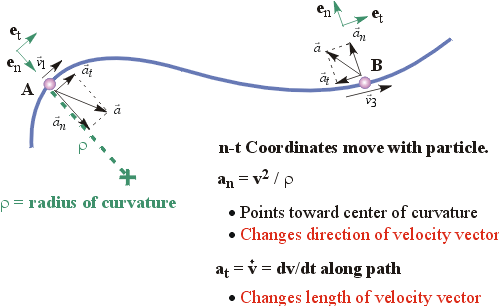
Picture:

1. Position: Normal-tangential (n-t) coordinates are attached to, and move with, a particle. Therefore there is no position vector in n-t coordinates. A typical n-t problem will either give the exact location of the particle on a path, or it will give kinematics information from which the position can be determined.
| 2. Velocity: Since velocity is always tangent to the path, we can write the velocity vector as |
|
where v is the speed of the particle.
| 3. Acceleration: Differentiating the velocity vector with respect to time gives: |
|
Why do two terms appear in this differentiation? The reason is that both v and et have time derivatives, so we use the product rule.
You know that v (speed) changes with time, so you expect it to have a time derivative.
But how does et change with time? Being a unit vector, its length remains one. But, because it moves with the particle, the direction of et changes continuously! So it has a time derivative that arises from this change in direction.
| 4. Tangential Acceleration: Time rate of change of the speed of the particle along the path. |
|
| 5. Normal Acceleration: Time rate of change of the direction of the velocity vector.. |

|
6. There are generally two kinds of problems that are primarily n-t problems:
(a) Circular path: A particle moves along a circular path with a constant radius, r.
(b) Non-Circular path: The particle’s speed and tangential acceleration will be given at a particular location. The radius of curvature, r, must be determined to calculate the normal acceleration.
7. Some problems which are primarily in x-y or r-q coordinates may ask for the velocity and acceleration vectors to be expressed in normal and tangential components. The vector relations shown on this reference page help in this conversion.